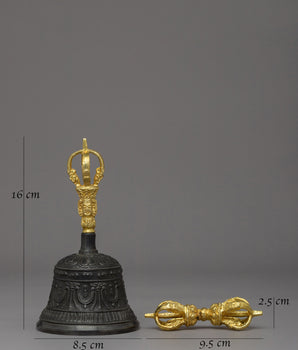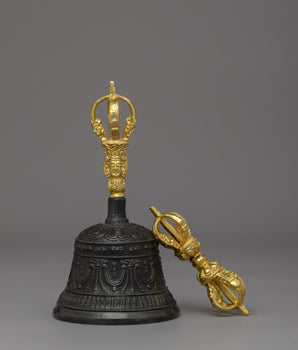The Highest Ritual Expression of Devotion in Tibetan Buddhism: Mandala Offering
When looking up the word "mandala" in general or even in specialized dictionaries, it is clear how challenging it is to adequately describe the concept in a few sentences. A "magic circle," a round "ritual-geometric" or "symbolic" design, or "usually a circle which surrounds a square with a central symbol, which may be a numeral" are some of the descriptions used to describe mandalas. Other definitions of mandalas include "symbolism of the cosmic elements, utilized as a help to meditation," "models for particular visualizations," "an aid to self-discovery or to meditate on the transcendental," and "models for certain patterns."
The representational "Grain Mandala" comprised of a visualized offering of Mt. Meru, The highest ritual expression of devotion in the Tibetan Buddhist tradition is the offering of a mandala, which symbolizes the entirety of the form and riches of the purified cosmos to one's lama, teacher, or meditational god (Tib. yi dam). Mandala is referred to as "something which circles ('khor') around a center (dkyil)" in Tibetan; its inner meaning is "absorbing the essence." When a request has been made for teachings or initiation, the grain mandala is customarily offered to the teacher. The complete giving of the universe symbolizes the most acceptable payment for the preciousness of the lessons.
Symbolism Of Mandala
![]()
Click here to view our Tibetan Mandala Set Collection
The Mandala is an offering to the Buddhas that serves as a symbolic depiction of the universe and all the valuable objects held within it. Buddhist cosmology describes our planet as flat with Mount Meru, a vast mountain at its center, surrounded by four continents, each of which has two major and several smaller sub-continents. There are billions of such worlds, and when we present the Mandala, we picture holding them in our hands, thinking of them as pure lands, and offering them up to the Buddhas.
The mind that desires to accumulate things for itself is being turned around by us. The ability to enjoy giving is something that we are developing with this practice. Engaging in this practice will reveal everything you are attached to, as well as whatever you are being frugal or stingy with.
Why Mandala Offering is Done?
In any description of why Mandala Offering is that one usually is told the story of the Bhikshuni Padma. She had been an Indian princess before she became a nun, and, through the practice of the Mandala Offering, she was able to meet directly the Bodhisattva Arya Avalokiteshvara (Chenrezig), as clearly as we can see one another here in this room. And by asking for and receiving instruction from this great Bodhisattva, she, as a result, was able to attain Enlightenment.
Mandala Offering is the symbolic offering of the prosperity of the whole universe. Mandala offering is a powerful method for accumulating extensive merit if we do it with proper visualization. Doing it this way, we dedicate the merit from each offering to the sentient beings as it is performed. It is very effective for the mind. It is essential to understand all about the offerings. Making the mandala offering is a way of clearing out all these negative states of mind. The mandala offering purifies our attachment, the stinginess, the miserliness, the clinging sense. It enriches the mind with the positive potential of giving. We create a lot of positive potential or merit just by giving. The mandala offering trains us to develop the sense that takes delight and joy in making other people happy. In doing so, we create merit.
Doing the mandala offering is a way of clearing out all these negative states of mind. Here, “mandala” means the universe and everything in it. Instead of looking at things and saying, “Oh that’s good. I want it!” we train ourselves to think, “Oh, that looks good. I’m offering it to the Triple Gem.” It’s a total reversal.
How to do Mandala Offering?
Offering the Mandala includes all six perfections in practice. You can improve the art of giving by cleansing and blessing the mandala base with liquid and a bajung pill (water symbolizes prosperity). The perfection of moral behavior results from inspecting the grain1 for insects and maintaining the base by keeping it clean. Patience is perfected by removing insects from grain without injuring them. You develop joyful effort by offering with joy and reflecting on how lucky you are to be able to practice the Dharma. You can achieve concentration by remembering to visualize. Wisdom is achieved by focusing on the Mandala's emptiness and vividly imagining its colors and objects.
What do we offer in Mandala?
For the base of the Mandala, you can even use a stone if you don't have any other suitable materials (but you must first obtain the spirit landlord's permission; otherwise, it would be theft). Lama Tsongkhapa spent his eight-year seclusion making mandala offerings on a stone, which left his forearm blue and bleeding with scabs and calluses. This does not imply that lamas lack the resources to purchase bases made of gold and silver. Lama Tsongkhapa did this to underline the value of moral purity.
How to Offer a Mandala
The mandala offering is a potent way to immediately attain realizations of bodhicitta and emptiness and accumulate a great deal of merit. Like carrying a considerable load requires enormous strength, bringing all sentient beings to Enlightenment requires immense merit. Nothing you can do with your hands is more worthy than making a mandala and offering it.
The practice consists of the ritual offering of the world, and all its wealth, to the Object of Refuge as an act of adoration. The Mandala is a symbolic representation of the world and the most valuable things in it. There are three forms to the practice: the Offering of the Outer Mandala, the Offering of the Inner Mandala, and the Offering of the Secret Mandala. The last is a practice done by followers of the Tantra Path.











